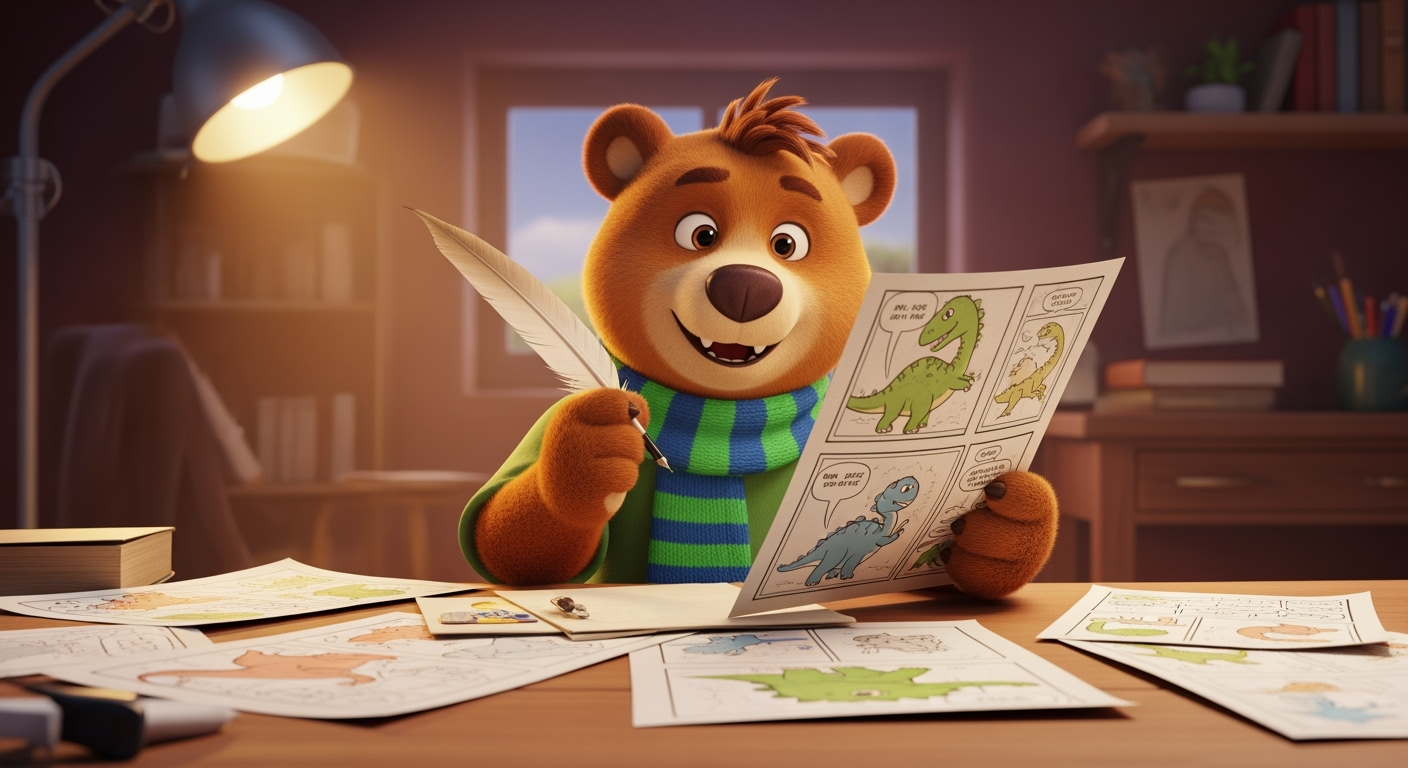
User Story: Understanding the Basics of AI Comic Templates
Children’s picture book comics have always held a special place in my heart and creative workflow. But as I—and many in the LlamaGen.AI community—experimented with the platform’s children’s picture book comic templates, we noticed an odd problem. Sometimes, the AI would add unexpected elements to our scripts, like cute dinosaurs popping into scenes where they didn’t belong. This template “over-processing” could even cause visual hallucinations or introduce extra characters not needed in the story. For creators building quality children’s comics, these surprises disrupted the storytelling flow and made the results less usable.
That’s why I’m excited to share how, by working closely with our community, we’ve optimized a specific children’s picture book comic template in LlamaGen.AI. Together, we identified the root causes, iterated on solutions, and ultimately removed unnecessary script processing. Now, our community enjoys higher-quality, more accurate comic templates—without unwanted surprises—making it easier than ever to bring your stories to life. In this comprehensive guide, I’ll walk you through what we learned, the solutions we implemented, and actionable best practices for anyone creating children’s comics using LlamaGen.AI.
Before we dive into the optimization journey, let’s clarify what comic templates do in LlamaGen.AI. Templates are pre-configured styles and logic that help creators quickly generate comics or storybooks in a specific format—like children’s picture books, manga, or webtoons. For children’s comics, templates often aim for a cute, engaging visual style, with accessible layouts and friendly character designs.
Key Concepts: Script Processing and Template Customization
One standout feature of LlamaGen.AI is its ability to process your script or prompt and turn it into a polished comic. However, some templates, especially those meant for picture books, go a step further—they “enhance” the script by adding extra elements, like cute animals or whimsical backgrounds. While this can sometimes spark creativity, it risks introducing characters or details not present in your story.
For example, a user might input a script about two children going on a picnic. If the template is set to add a “cute dinosaur” by default, the comic could show a dinosaur joining the picnic—completely unplanned! This kind of extra processing is what we call “template-induced hallucination.”
Common Challenges: Unintended Characters and Visual Hallucinations
The main issues with over-processed templates include:
- Unexpected characters appearing in panels (e.g., dinosaurs, animals, or objects not in the script)
- Visual hallucinations where scenes don’t match the story intent
- Loss of script fidelity, making it hard to control the narrative
Creators, educators, and marketers using LlamaGen.AI for children’s comics need their stories to be consistent and true to the script. That’s why addressing these challenges was so important.
Step-by-Step Implementation: Optimizing the Children’s Comic Template in LlamaGen.AI
Through hands-on use and active conversations in the LlamaGen.AI community, we mapped out a clear process to solve this problem and improve the template for everyone.
Prerequisites: What You Need
- A LlamaGen.AI account (get started here)
- Access to the children’s picture book style comic template
- Your script or story idea (in any supported language)
- Willingness to iterate and provide feedback
Implementation Steps: How We Solved the Template Issue
-
Community Feedback Collection
- We encouraged users to share examples where the template added unwanted elements.
- Screenshots and scripts were posted in the community Discord and Reddit group.
-
Identifying Template Logic Issues
- Technical review revealed that the template had preset prompts to add “cute” characters (like dinosaurs), regardless of the user’s script.
- This extra processing caused the AI to hallucinate details not in the original story.
-
Collaborative Analysis and Testing
- Community members, artists, and the LlamaGen.AI team analyzed problematic outputs together.
- We pinpointed which parts of the template logic needed to be removed or adjusted for fidelity.
-
Template Optimization
- Developers updated the template to eliminate forced “cute” character additions.
- The AI now respects the user’s input strictly—no more surprise dinosaurs unless you ask for them!
-
User Validation and Quality Control
- The community tested the new version with a variety of scripts.
- Results showed far fewer hallucinations and greater satisfaction with the output.
-
Documentation and Tutorial Updates
- We published step-by-step guides and video tutorials to help new users get the most out of the improved template.
Example: Before and After Optimization
- Before: A script about “a little girl finding a lost puppy” automatically included a friendly dinosaur in every panel.
- After: The same script now only features the girl and the puppy, perfectly matching the narrative.
Best Practices and Tips for Creating High-Quality Children’s Comics with LlamaGen.AI
With the optimized template in place, here are some actionable ways to get the best results:
1. Write Clear, Specific Scripts
The more detailed your script, the better LlamaGen.AI can visualize it. For example:
- Instead of: “A boy explores a forest.”
- Try: “A young boy named Tim walks through a bright green forest looking for his red kite.”
2. Use Character Consistency Features
LlamaGen.AI’s Character Consistency Engine helps keep your main characters’ appearance the same across every panel. Use persistent character references and outfit controls to avoid accidental changes.
3. Leverage Panel-Level Editing
If you notice something off in a panel, use the redraw and negative prompt features to remove unwanted elements. You can also toggle speech bubbles for custom lettering.
4. Involve the Community
Share your comics and get feedback in the LlamaGen.AI community or Facebook group. Community input was crucial to optimizing this template, and your suggestions can drive future improvements.
5. Experiment with Artistic Modes
Try different art styles, color palettes, and layouts. LlamaGen.AI supports multi-panel comics and 4K imagery for professional results.
6. Keep Up with Tutorials and Updates
Check the Video Learning Hub for new guides, or explore the academy series for in-depth tips on comic creation.
Common Mistakes to Avoid
- Using vague prompts: Leads to generic or unexpected results.
- Ignoring character references: Can cause inconsistency across panels.
- Overlooking template settings: Double-check that you’re using the latest optimized version.
Frequently Asked Questions about LlamaGen.AI Comic Templates
How do I select the right template for my project?
Choose a template that matches your story’s audience and style. For children’s books, use the revamped children’s comic template for best fidelity.
Can I customize the template further?
Absolutely. Use the advanced customization tools to tweak layouts, characters, and panel order. Refer to the official documentation for detailed instructions.
What if I still see unwanted characters?
- Use the negative prompt feature to exclude specific elements (e.g., “no dinosaurs”).
- Double-check your script for keywords that might trigger template enhancements.
- Contact support or join the community to report persistent issues.
Conclusion
Optimizing the children’s picture book comic template in LlamaGen.AI was a true community effort. By listening to user experiences and collaborating on solutions, we transformed a frustrating problem—unwanted cute dinosaurs and over-processed scripts—into an opportunity for higher quality and creative control.
If you’re looking to create compelling children’s comics, start with the improved template on LlamaGen.AI. Write clear scripts, use character consistency tools, and don’t hesitate to share your work for feedback. For more tutorials and best practices, visit the LlamaGen.AI Video Learning Hub, join our community, and explore related topics like comic API integration and storyboard generation.
Ready to bring your stories to life? Sign up for a free account, try the optimized template, and let’s keep building the future of visual storytelling—together.
UserStory
guide
tutorial
tips
best practices
advanced
Previous blogs
Advanced Strategies That Actually Work for Safe AI Integration
Discover if you’ve ever tried to scale creative ai workflows—especially with something as visually d
User Story: Understanding the Basics of AI Comic Templates
Discover children’s picture book comics have always held a special place in my heart and creative wo
Understanding the Basics of ePub Export for Storyboards
Discover if you’ve ever tried exporting storyboards or comics to epub format, you’ve probably run in
User Story: How We Solved 6-Character Comic Consistency in 48 Hours: The French Enterprise Success Story
Discover creating visually consistent comics with multiple characters is a challenge many storytelle
Spark dreams for the young
Where millions of stories come alive
A rundown of the latest LlamaGen.Ai feature releases, product enhancements, design updates, and important bug fixes.
